Racism as a Social Determinant of Health Against Syrians in Australia
VerifiedAdded on 2022/12/30
|14
|3683
|39
AI Summary
This article discusses the issue of racism against Syrians in Australia and its impact on their health. It explores the various social determinants of health and the measures taken to address racism. Recommendations for tackling racism are also provided.
Contribute Materials
Your contribution can guide someone’s learning journey. Share your
documents today.
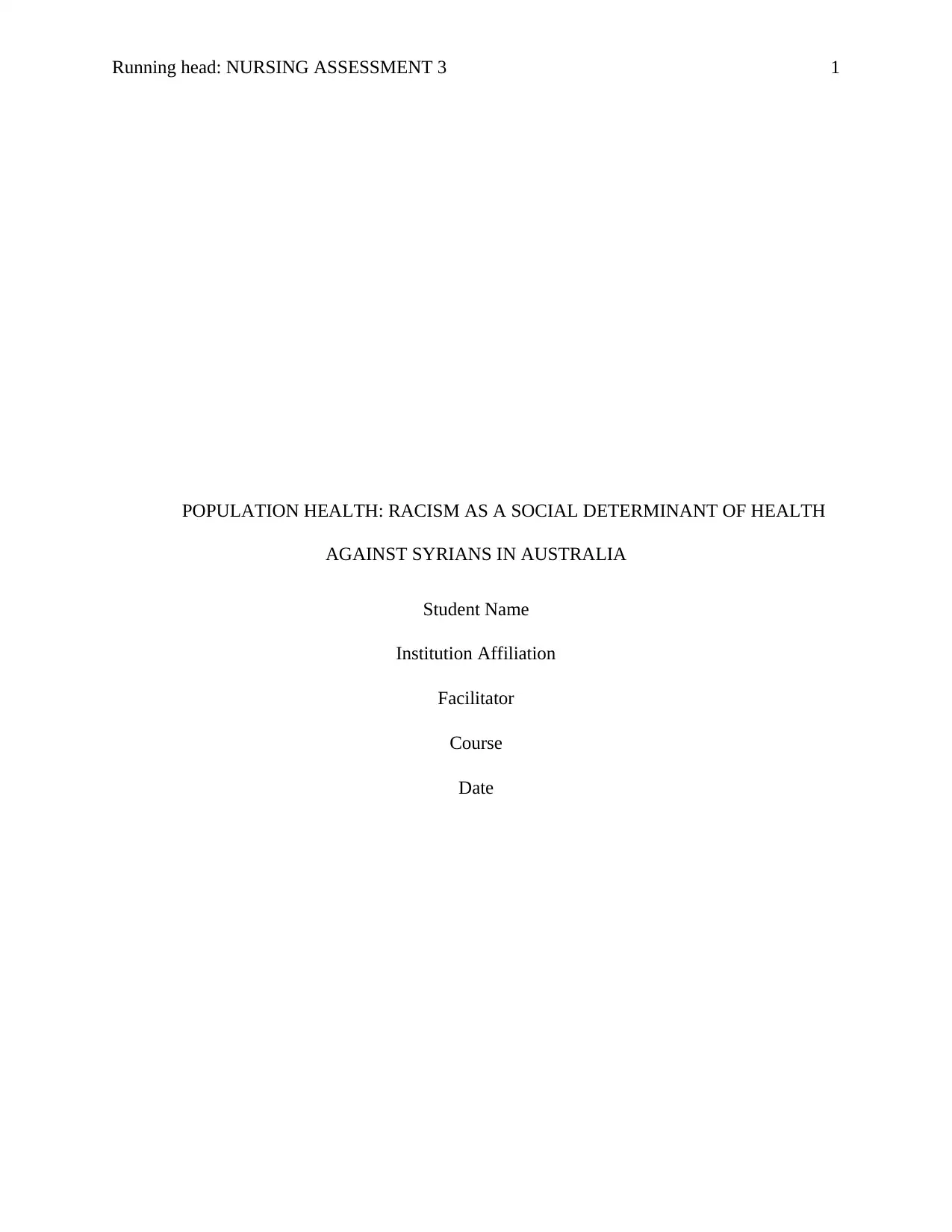
Running head: NURSING ASSESSMENT 3 1
POPULATION HEALTH: RACISM AS A SOCIAL DETERMINANT OF HEALTH
AGAINST SYRIANS IN AUSTRALIA
Student Name
Institution Affiliation
Facilitator
Course
Date
POPULATION HEALTH: RACISM AS A SOCIAL DETERMINANT OF HEALTH
AGAINST SYRIANS IN AUSTRALIA
Student Name
Institution Affiliation
Facilitator
Course
Date
Secure Best Marks with AI Grader
Need help grading? Try our AI Grader for instant feedback on your assignments.
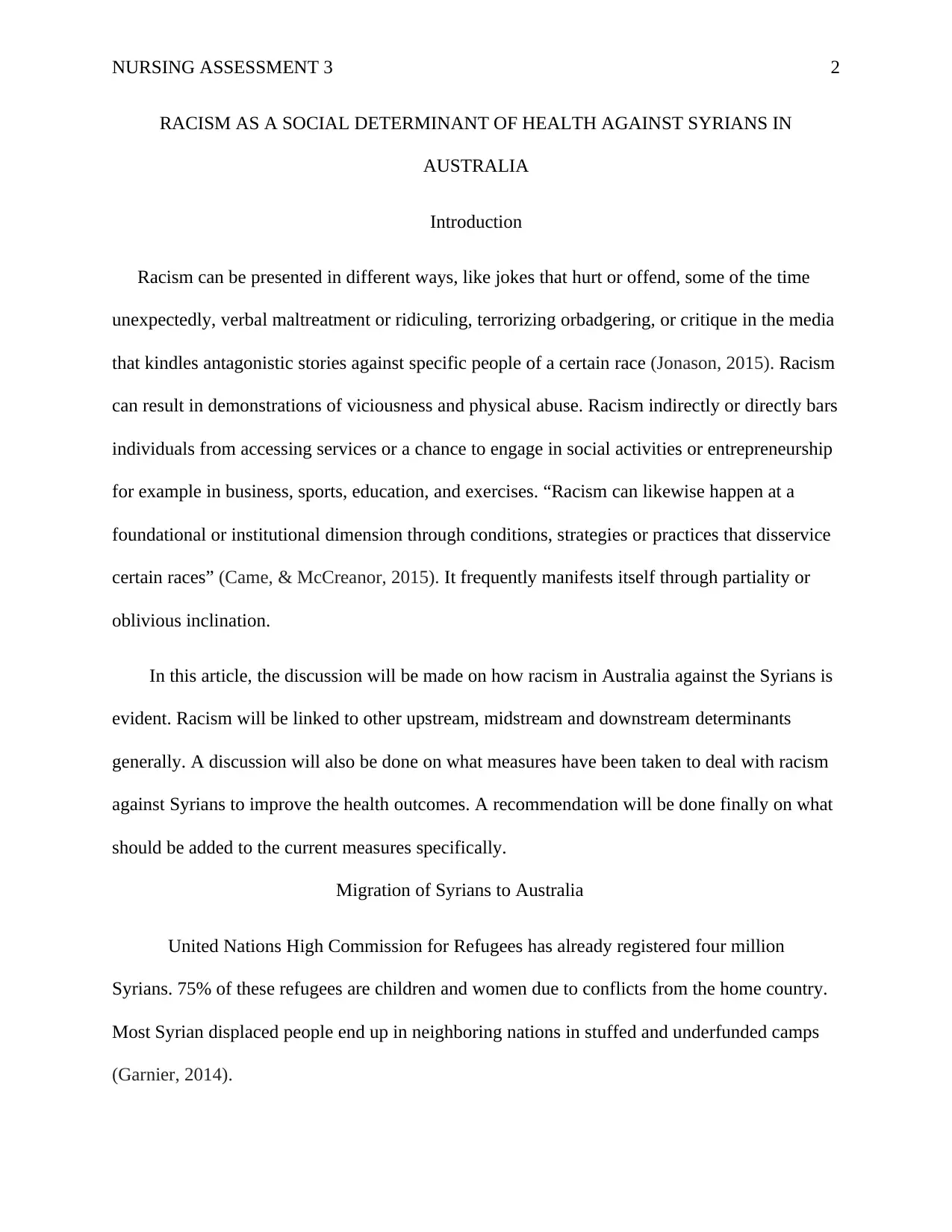
NURSING ASSESSMENT 3 2
RACISM AS A SOCIAL DETERMINANT OF HEALTH AGAINST SYRIANS IN
AUSTRALIA
Introduction
Racism can be presented in different ways, like jokes that hurt or offend, some of the time
unexpectedly, verbal maltreatment or ridiculing, terrorizing orbadgering, or critique in the media
that kindles antagonistic stories against specific people of a certain race (Jonason, 2015). Racism
can result in demonstrations of viciousness and physical abuse. Racism indirectly or directly bars
individuals from accessing services or a chance to engage in social activities or entrepreneurship
for example in business, sports, education, and exercises. “Racism can likewise happen at a
foundational or institutional dimension through conditions, strategies or practices that disservice
certain races” (Came, & McCreanor, 2015). It frequently manifests itself through partiality or
oblivious inclination.
In this article, the discussion will be made on how racism in Australia against the Syrians is
evident. Racism will be linked to other upstream, midstream and downstream determinants
generally. A discussion will also be done on what measures have been taken to deal with racism
against Syrians to improve the health outcomes. A recommendation will be done finally on what
should be added to the current measures specifically.
Migration of Syrians to Australia
United Nations High Commission for Refugees has already registered four million
Syrians. 75% of these refugees are children and women due to conflicts from the home country.
Most Syrian displaced people end up in neighboring nations in stuffed and underfunded camps
(Garnier, 2014).
RACISM AS A SOCIAL DETERMINANT OF HEALTH AGAINST SYRIANS IN
AUSTRALIA
Introduction
Racism can be presented in different ways, like jokes that hurt or offend, some of the time
unexpectedly, verbal maltreatment or ridiculing, terrorizing orbadgering, or critique in the media
that kindles antagonistic stories against specific people of a certain race (Jonason, 2015). Racism
can result in demonstrations of viciousness and physical abuse. Racism indirectly or directly bars
individuals from accessing services or a chance to engage in social activities or entrepreneurship
for example in business, sports, education, and exercises. “Racism can likewise happen at a
foundational or institutional dimension through conditions, strategies or practices that disservice
certain races” (Came, & McCreanor, 2015). It frequently manifests itself through partiality or
oblivious inclination.
In this article, the discussion will be made on how racism in Australia against the Syrians is
evident. Racism will be linked to other upstream, midstream and downstream determinants
generally. A discussion will also be done on what measures have been taken to deal with racism
against Syrians to improve the health outcomes. A recommendation will be done finally on what
should be added to the current measures specifically.
Migration of Syrians to Australia
United Nations High Commission for Refugees has already registered four million
Syrians. 75% of these refugees are children and women due to conflicts from the home country.
Most Syrian displaced people end up in neighboring nations in stuffed and underfunded camps
(Garnier, 2014).
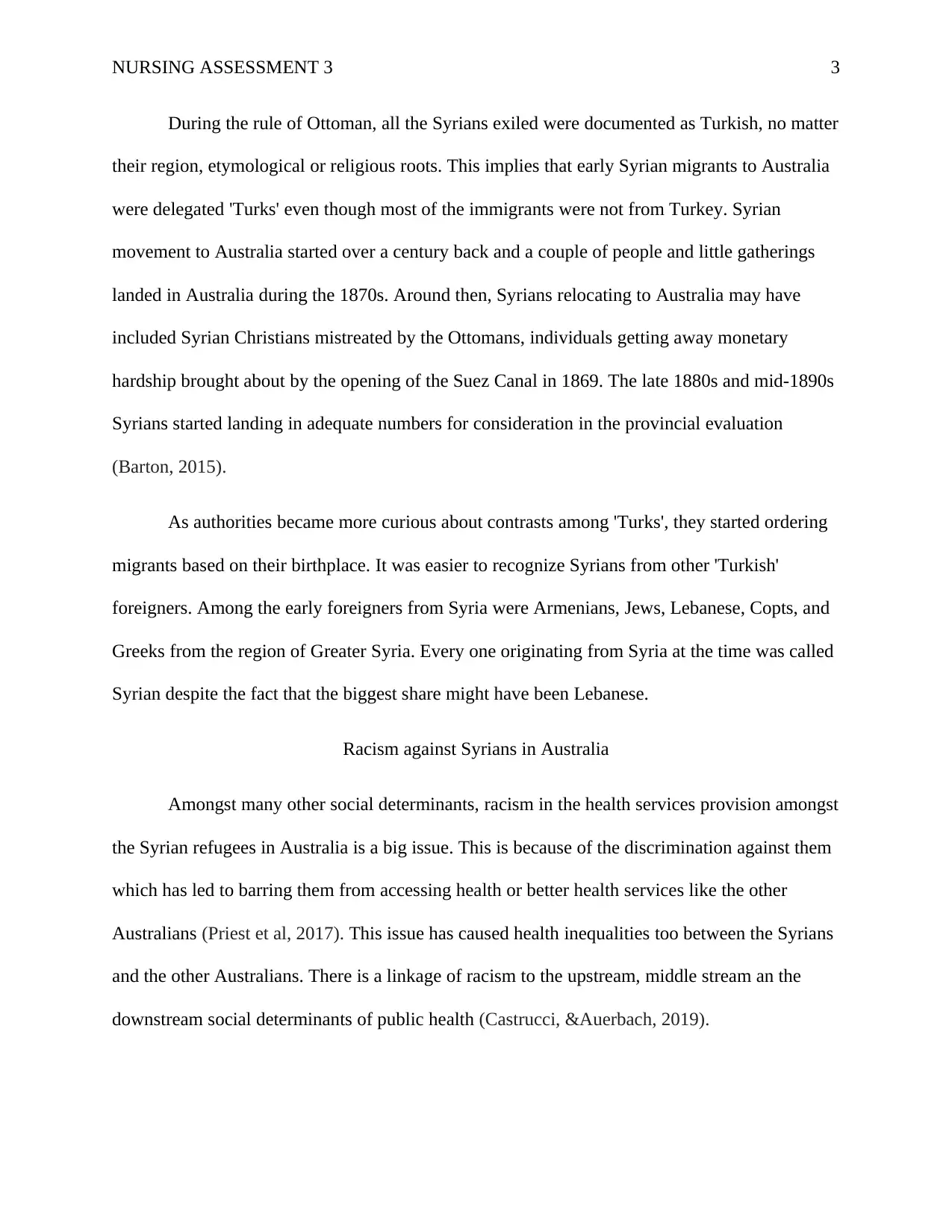
NURSING ASSESSMENT 3 3
During the rule of Ottoman, all the Syrians exiled were documented as Turkish, no matter
their region, etymological or religious roots. This implies that early Syrian migrants to Australia
were delegated 'Turks' even though most of the immigrants were not from Turkey. Syrian
movement to Australia started over a century back and a couple of people and little gatherings
landed in Australia during the 1870s. Around then, Syrians relocating to Australia may have
included Syrian Christians mistreated by the Ottomans, individuals getting away monetary
hardship brought about by the opening of the Suez Canal in 1869. The late 1880s and mid-1890s
Syrians started landing in adequate numbers for consideration in the provincial evaluation
(Barton, 2015).
As authorities became more curious about contrasts among 'Turks', they started ordering
migrants based on their birthplace. It was easier to recognize Syrians from other 'Turkish'
foreigners. Among the early foreigners from Syria were Armenians, Jews, Lebanese, Copts, and
Greeks from the region of Greater Syria. Every one originating from Syria at the time was called
Syrian despite the fact that the biggest share might have been Lebanese.
Racism against Syrians in Australia
Amongst many other social determinants, racism in the health services provision amongst
the Syrian refugees in Australia is a big issue. This is because of the discrimination against them
which has led to barring them from accessing health or better health services like the other
Australians (Priest et al, 2017). This issue has caused health inequalities too between the Syrians
and the other Australians. There is a linkage of racism to the upstream, middle stream an the
downstream social determinants of public health (Castrucci, &Auerbach, 2019).
During the rule of Ottoman, all the Syrians exiled were documented as Turkish, no matter
their region, etymological or religious roots. This implies that early Syrian migrants to Australia
were delegated 'Turks' even though most of the immigrants were not from Turkey. Syrian
movement to Australia started over a century back and a couple of people and little gatherings
landed in Australia during the 1870s. Around then, Syrians relocating to Australia may have
included Syrian Christians mistreated by the Ottomans, individuals getting away monetary
hardship brought about by the opening of the Suez Canal in 1869. The late 1880s and mid-1890s
Syrians started landing in adequate numbers for consideration in the provincial evaluation
(Barton, 2015).
As authorities became more curious about contrasts among 'Turks', they started ordering
migrants based on their birthplace. It was easier to recognize Syrians from other 'Turkish'
foreigners. Among the early foreigners from Syria were Armenians, Jews, Lebanese, Copts, and
Greeks from the region of Greater Syria. Every one originating from Syria at the time was called
Syrian despite the fact that the biggest share might have been Lebanese.
Racism against Syrians in Australia
Amongst many other social determinants, racism in the health services provision amongst
the Syrian refugees in Australia is a big issue. This is because of the discrimination against them
which has led to barring them from accessing health or better health services like the other
Australians (Priest et al, 2017). This issue has caused health inequalities too between the Syrians
and the other Australians. There is a linkage of racism to the upstream, middle stream an the
downstream social determinants of public health (Castrucci, &Auerbach, 2019).
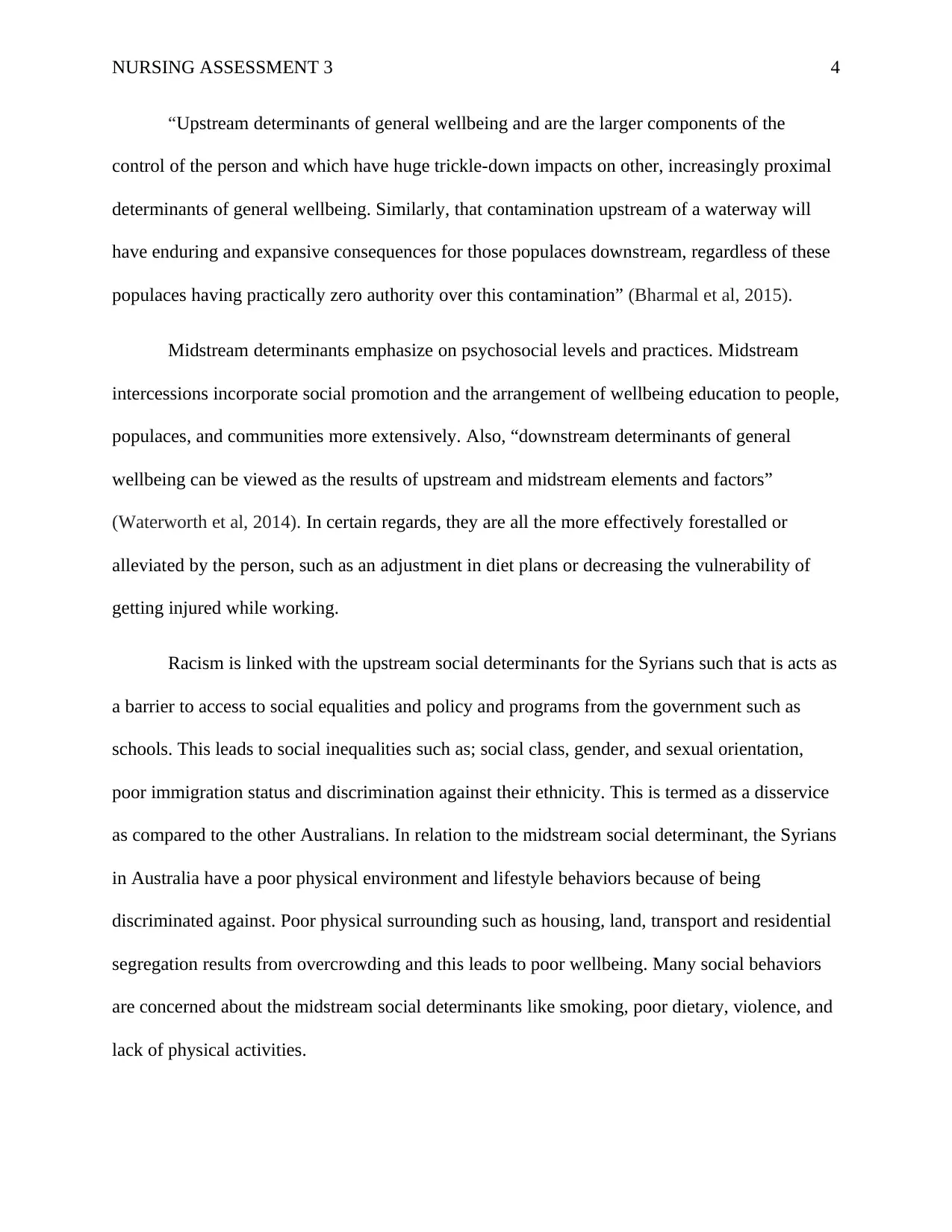
NURSING ASSESSMENT 3 4
“Upstream determinants of general wellbeing and are the larger components of the
control of the person and which have huge trickle-down impacts on other, increasingly proximal
determinants of general wellbeing. Similarly, that contamination upstream of a waterway will
have enduring and expansive consequences for those populaces downstream, regardless of these
populaces having practically zero authority over this contamination” (Bharmal et al, 2015).
Midstream determinants emphasize on psychosocial levels and practices. Midstream
intercessions incorporate social promotion and the arrangement of wellbeing education to people,
populaces, and communities more extensively. Also, “downstream determinants of general
wellbeing can be viewed as the results of upstream and midstream elements and factors”
(Waterworth et al, 2014). In certain regards, they are all the more effectively forestalled or
alleviated by the person, such as an adjustment in diet plans or decreasing the vulnerability of
getting injured while working.
Racism is linked with the upstream social determinants for the Syrians such that is acts as
a barrier to access to social equalities and policy and programs from the government such as
schools. This leads to social inequalities such as; social class, gender, and sexual orientation,
poor immigration status and discrimination against their ethnicity. This is termed as a disservice
as compared to the other Australians. In relation to the midstream social determinant, the Syrians
in Australia have a poor physical environment and lifestyle behaviors because of being
discriminated against. Poor physical surrounding such as housing, land, transport and residential
segregation results from overcrowding and this leads to poor wellbeing. Many social behaviors
are concerned about the midstream social determinants like smoking, poor dietary, violence, and
lack of physical activities.
“Upstream determinants of general wellbeing and are the larger components of the
control of the person and which have huge trickle-down impacts on other, increasingly proximal
determinants of general wellbeing. Similarly, that contamination upstream of a waterway will
have enduring and expansive consequences for those populaces downstream, regardless of these
populaces having practically zero authority over this contamination” (Bharmal et al, 2015).
Midstream determinants emphasize on psychosocial levels and practices. Midstream
intercessions incorporate social promotion and the arrangement of wellbeing education to people,
populaces, and communities more extensively. Also, “downstream determinants of general
wellbeing can be viewed as the results of upstream and midstream elements and factors”
(Waterworth et al, 2014). In certain regards, they are all the more effectively forestalled or
alleviated by the person, such as an adjustment in diet plans or decreasing the vulnerability of
getting injured while working.
Racism is linked with the upstream social determinants for the Syrians such that is acts as
a barrier to access to social equalities and policy and programs from the government such as
schools. This leads to social inequalities such as; social class, gender, and sexual orientation,
poor immigration status and discrimination against their ethnicity. This is termed as a disservice
as compared to the other Australians. In relation to the midstream social determinant, the Syrians
in Australia have a poor physical environment and lifestyle behaviors because of being
discriminated against. Poor physical surrounding such as housing, land, transport and residential
segregation results from overcrowding and this leads to poor wellbeing. Many social behaviors
are concerned about the midstream social determinants like smoking, poor dietary, violence, and
lack of physical activities.
Secure Best Marks with AI Grader
Need help grading? Try our AI Grader for instant feedback on your assignments.
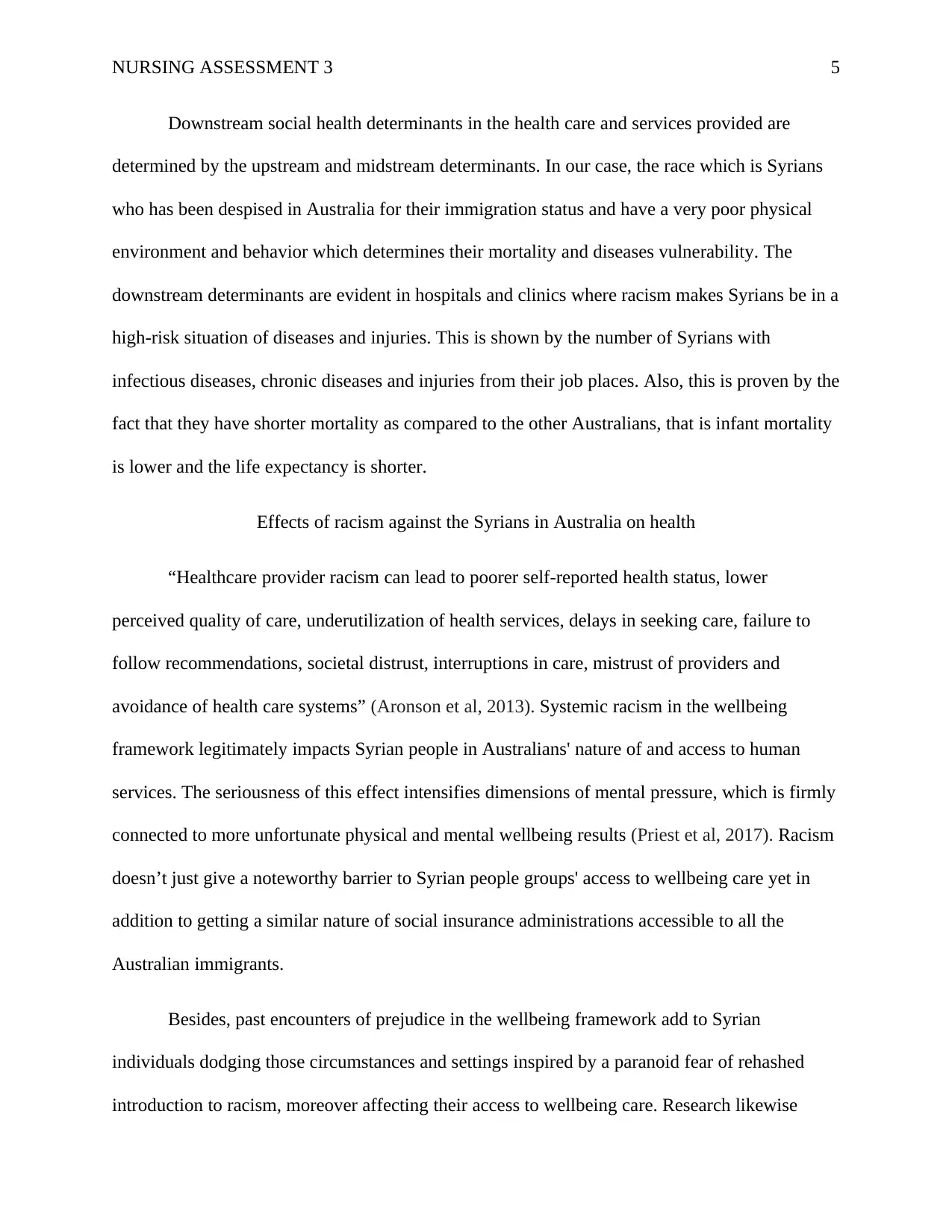
NURSING ASSESSMENT 3 5
Downstream social health determinants in the health care and services provided are
determined by the upstream and midstream determinants. In our case, the race which is Syrians
who has been despised in Australia for their immigration status and have a very poor physical
environment and behavior which determines their mortality and diseases vulnerability. The
downstream determinants are evident in hospitals and clinics where racism makes Syrians be in a
high-risk situation of diseases and injuries. This is shown by the number of Syrians with
infectious diseases, chronic diseases and injuries from their job places. Also, this is proven by the
fact that they have shorter mortality as compared to the other Australians, that is infant mortality
is lower and the life expectancy is shorter.
Effects of racism against the Syrians in Australia on health
“Healthcare provider racism can lead to poorer self-reported health status, lower
perceived quality of care, underutilization of health services, delays in seeking care, failure to
follow recommendations, societal distrust, interruptions in care, mistrust of providers and
avoidance of health care systems” (Aronson et al, 2013). Systemic racism in the wellbeing
framework legitimately impacts Syrian people in Australians' nature of and access to human
services. The seriousness of this effect intensifies dimensions of mental pressure, which is firmly
connected to more unfortunate physical and mental wellbeing results (Priest et al, 2017). Racism
doesn’t just give a noteworthy barrier to Syrian people groups' access to wellbeing care yet in
addition to getting a similar nature of social insurance administrations accessible to all the
Australian immigrants.
Besides, past encounters of prejudice in the wellbeing framework add to Syrian
individuals dodging those circumstances and settings inspired by a paranoid fear of rehashed
introduction to racism, moreover affecting their access to wellbeing care. Research likewise
Downstream social health determinants in the health care and services provided are
determined by the upstream and midstream determinants. In our case, the race which is Syrians
who has been despised in Australia for their immigration status and have a very poor physical
environment and behavior which determines their mortality and diseases vulnerability. The
downstream determinants are evident in hospitals and clinics where racism makes Syrians be in a
high-risk situation of diseases and injuries. This is shown by the number of Syrians with
infectious diseases, chronic diseases and injuries from their job places. Also, this is proven by the
fact that they have shorter mortality as compared to the other Australians, that is infant mortality
is lower and the life expectancy is shorter.
Effects of racism against the Syrians in Australia on health
“Healthcare provider racism can lead to poorer self-reported health status, lower
perceived quality of care, underutilization of health services, delays in seeking care, failure to
follow recommendations, societal distrust, interruptions in care, mistrust of providers and
avoidance of health care systems” (Aronson et al, 2013). Systemic racism in the wellbeing
framework legitimately impacts Syrian people in Australians' nature of and access to human
services. The seriousness of this effect intensifies dimensions of mental pressure, which is firmly
connected to more unfortunate physical and mental wellbeing results (Priest et al, 2017). Racism
doesn’t just give a noteworthy barrier to Syrian people groups' access to wellbeing care yet in
addition to getting a similar nature of social insurance administrations accessible to all the
Australian immigrants.
Besides, past encounters of prejudice in the wellbeing framework add to Syrian
individuals dodging those circumstances and settings inspired by a paranoid fear of rehashed
introduction to racism, moreover affecting their access to wellbeing care. Research likewise
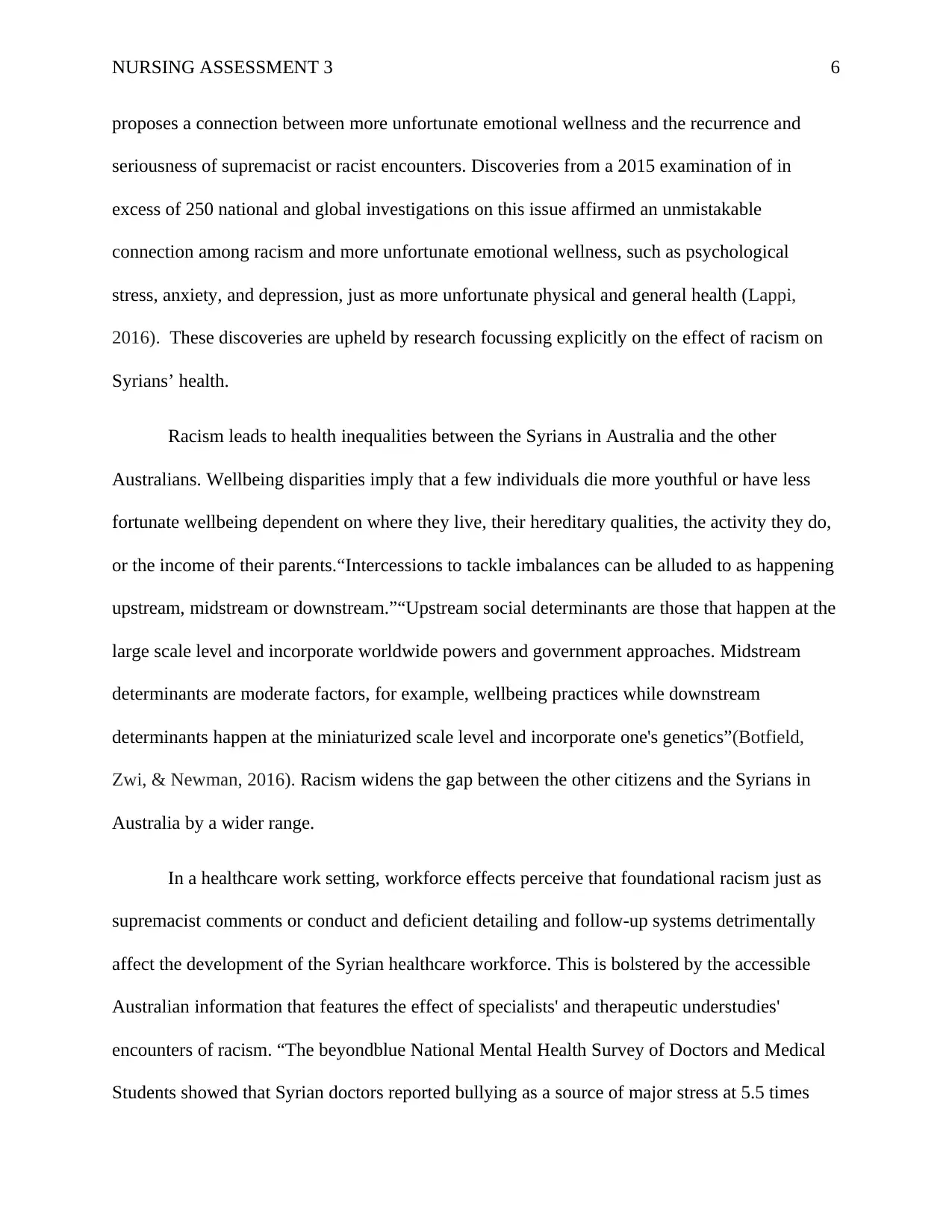
NURSING ASSESSMENT 3 6
proposes a connection between more unfortunate emotional wellness and the recurrence and
seriousness of supremacist or racist encounters. Discoveries from a 2015 examination of in
excess of 250 national and global investigations on this issue affirmed an unmistakable
connection among racism and more unfortunate emotional wellness, such as psychological
stress, anxiety, and depression, just as more unfortunate physical and general health (Lappi,
2016). These discoveries are upheld by research focussing explicitly on the effect of racism on
Syrians’ health.
Racism leads to health inequalities between the Syrians in Australia and the other
Australians. Wellbeing disparities imply that a few individuals die more youthful or have less
fortunate wellbeing dependent on where they live, their hereditary qualities, the activity they do,
or the income of their parents.“Intercessions to tackle imbalances can be alluded to as happening
upstream, midstream or downstream.”“Upstream social determinants are those that happen at the
large scale level and incorporate worldwide powers and government approaches. Midstream
determinants are moderate factors, for example, wellbeing practices while downstream
determinants happen at the miniaturized scale level and incorporate one's genetics”(Botfield,
Zwi, & Newman, 2016). Racism widens the gap between the other citizens and the Syrians in
Australia by a wider range.
In a healthcare work setting, workforce effects perceive that foundational racism just as
supremacist comments or conduct and deficient detailing and follow-up systems detrimentally
affect the development of the Syrian healthcare workforce. This is bolstered by the accessible
Australian information that features the effect of specialists' and therapeutic understudies'
encounters of racism. “The beyondblue National Mental Health Survey of Doctors and Medical
Students showed that Syrian doctors reported bullying as a source of major stress at 5.5 times
proposes a connection between more unfortunate emotional wellness and the recurrence and
seriousness of supremacist or racist encounters. Discoveries from a 2015 examination of in
excess of 250 national and global investigations on this issue affirmed an unmistakable
connection among racism and more unfortunate emotional wellness, such as psychological
stress, anxiety, and depression, just as more unfortunate physical and general health (Lappi,
2016). These discoveries are upheld by research focussing explicitly on the effect of racism on
Syrians’ health.
Racism leads to health inequalities between the Syrians in Australia and the other
Australians. Wellbeing disparities imply that a few individuals die more youthful or have less
fortunate wellbeing dependent on where they live, their hereditary qualities, the activity they do,
or the income of their parents.“Intercessions to tackle imbalances can be alluded to as happening
upstream, midstream or downstream.”“Upstream social determinants are those that happen at the
large scale level and incorporate worldwide powers and government approaches. Midstream
determinants are moderate factors, for example, wellbeing practices while downstream
determinants happen at the miniaturized scale level and incorporate one's genetics”(Botfield,
Zwi, & Newman, 2016). Racism widens the gap between the other citizens and the Syrians in
Australia by a wider range.
In a healthcare work setting, workforce effects perceive that foundational racism just as
supremacist comments or conduct and deficient detailing and follow-up systems detrimentally
affect the development of the Syrian healthcare workforce. This is bolstered by the accessible
Australian information that features the effect of specialists' and therapeutic understudies'
encounters of racism. “The beyondblue National Mental Health Survey of Doctors and Medical
Students showed that Syrian doctors reported bullying as a source of major stress at 5.5 times
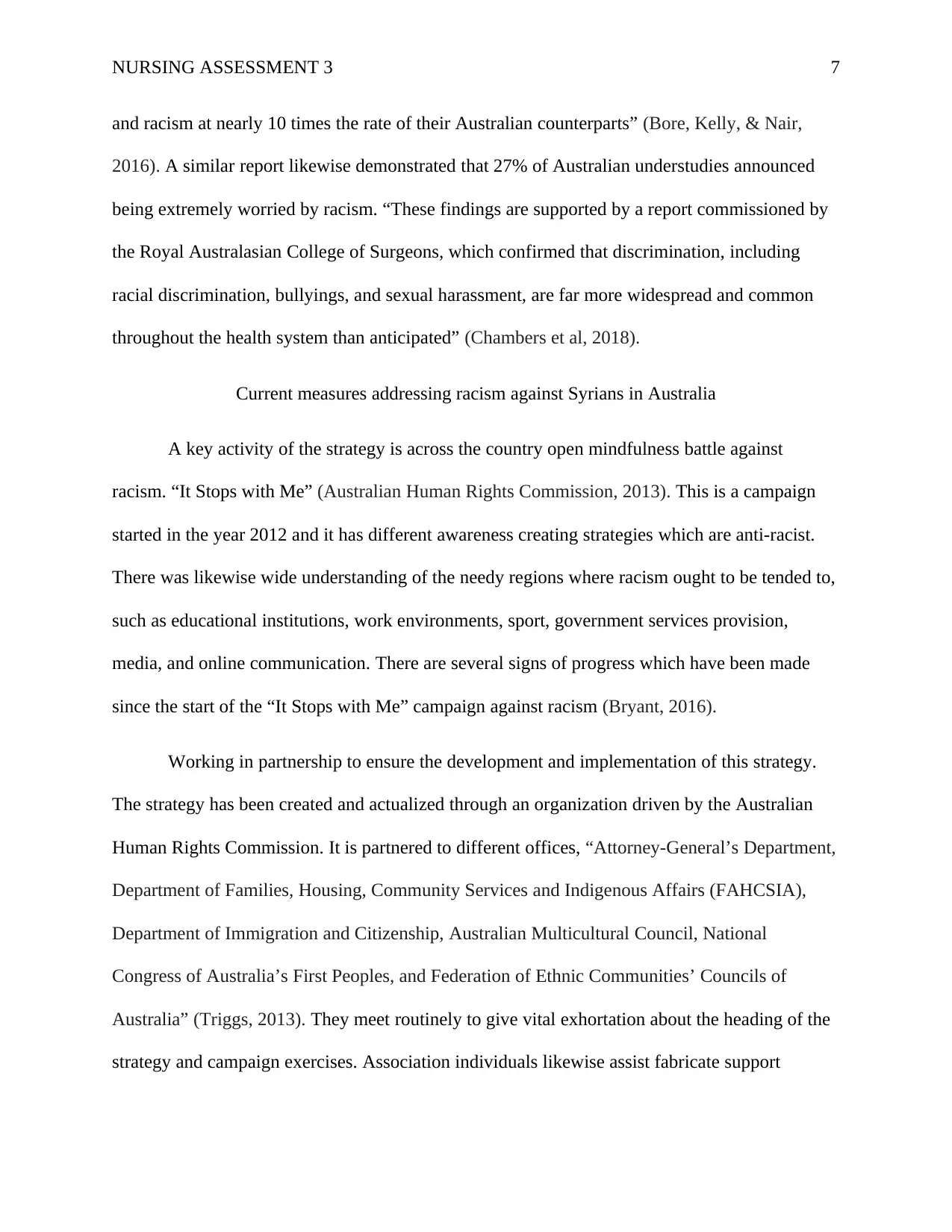
NURSING ASSESSMENT 3 7
and racism at nearly 10 times the rate of their Australian counterparts” (Bore, Kelly, & Nair,
2016). A similar report likewise demonstrated that 27% of Australian understudies announced
being extremely worried by racism. “These findings are supported by a report commissioned by
the Royal Australasian College of Surgeons, which confirmed that discrimination, including
racial discrimination, bullyings, and sexual harassment, are far more widespread and common
throughout the health system than anticipated” (Chambers et al, 2018).
Current measures addressing racism against Syrians in Australia
A key activity of the strategy is across the country open mindfulness battle against
racism. “It Stops with Me” (Australian Human Rights Commission, 2013). This is a campaign
started in the year 2012 and it has different awareness creating strategies which are anti-racist.
There was likewise wide understanding of the needy regions where racism ought to be tended to,
such as educational institutions, work environments, sport, government services provision,
media, and online communication. There are several signs of progress which have been made
since the start of the “It Stops with Me” campaign against racism (Bryant, 2016).
Working in partnership to ensure the development and implementation of this strategy.
The strategy has been created and actualized through an organization driven by the Australian
Human Rights Commission. It is partnered to different offices, “Attorney-General’s Department,
Department of Families, Housing, Community Services and Indigenous Affairs (FAHCSIA),
Department of Immigration and Citizenship, Australian Multicultural Council, National
Congress of Australia’s First Peoples, and Federation of Ethnic Communities’ Councils of
Australia” (Triggs, 2013). They meet routinely to give vital exhortation about the heading of the
strategy and campaign exercises. Association individuals likewise assist fabricate support
and racism at nearly 10 times the rate of their Australian counterparts” (Bore, Kelly, & Nair,
2016). A similar report likewise demonstrated that 27% of Australian understudies announced
being extremely worried by racism. “These findings are supported by a report commissioned by
the Royal Australasian College of Surgeons, which confirmed that discrimination, including
racial discrimination, bullyings, and sexual harassment, are far more widespread and common
throughout the health system than anticipated” (Chambers et al, 2018).
Current measures addressing racism against Syrians in Australia
A key activity of the strategy is across the country open mindfulness battle against
racism. “It Stops with Me” (Australian Human Rights Commission, 2013). This is a campaign
started in the year 2012 and it has different awareness creating strategies which are anti-racist.
There was likewise wide understanding of the needy regions where racism ought to be tended to,
such as educational institutions, work environments, sport, government services provision,
media, and online communication. There are several signs of progress which have been made
since the start of the “It Stops with Me” campaign against racism (Bryant, 2016).
Working in partnership to ensure the development and implementation of this strategy.
The strategy has been created and actualized through an organization driven by the Australian
Human Rights Commission. It is partnered to different offices, “Attorney-General’s Department,
Department of Families, Housing, Community Services and Indigenous Affairs (FAHCSIA),
Department of Immigration and Citizenship, Australian Multicultural Council, National
Congress of Australia’s First Peoples, and Federation of Ethnic Communities’ Councils of
Australia” (Triggs, 2013). They meet routinely to give vital exhortation about the heading of the
strategy and campaign exercises. Association individuals likewise assist fabricate support
Paraphrase This Document
Need a fresh take? Get an instant paraphrase of this document with our AI Paraphraser
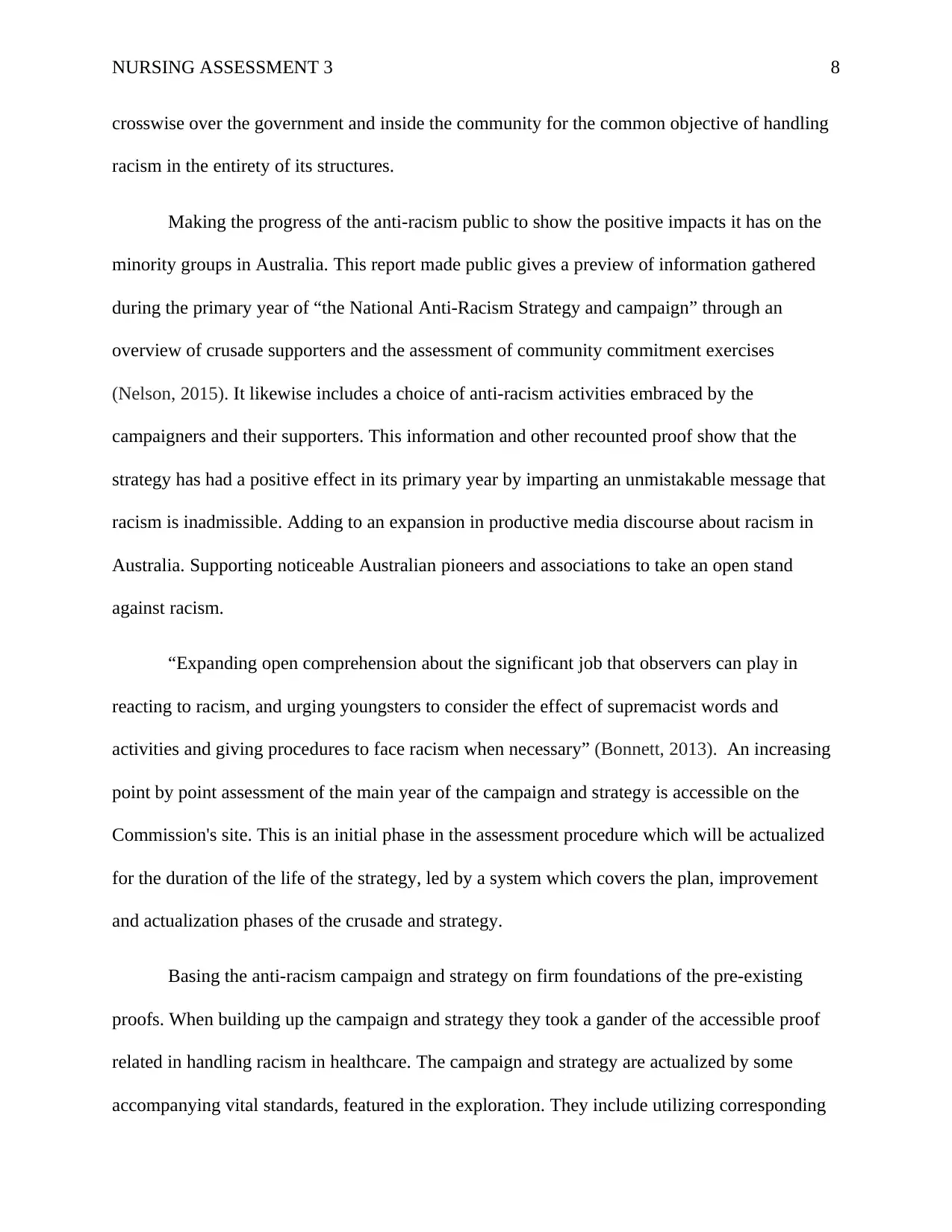
NURSING ASSESSMENT 3 8
crosswise over the government and inside the community for the common objective of handling
racism in the entirety of its structures.
Making the progress of the anti-racism public to show the positive impacts it has on the
minority groups in Australia. This report made public gives a preview of information gathered
during the primary year of “the National Anti-Racism Strategy and campaign” through an
overview of crusade supporters and the assessment of community commitment exercises
(Nelson, 2015). It likewise includes a choice of anti-racism activities embraced by the
campaigners and their supporters. This information and other recounted proof show that the
strategy has had a positive effect in its primary year by imparting an unmistakable message that
racism is inadmissible. Adding to an expansion in productive media discourse about racism in
Australia. Supporting noticeable Australian pioneers and associations to take an open stand
against racism.
“Expanding open comprehension about the significant job that observers can play in
reacting to racism, and urging youngsters to consider the effect of supremacist words and
activities and giving procedures to face racism when necessary” (Bonnett, 2013). An increasing
point by point assessment of the main year of the campaign and strategy is accessible on the
Commission's site. This is an initial phase in the assessment procedure which will be actualized
for the duration of the life of the strategy, led by a system which covers the plan, improvement
and actualization phases of the crusade and strategy.
Basing the anti-racism campaign and strategy on firm foundations of the pre-existing
proofs. When building up the campaign and strategy they took a gander of the accessible proof
related in handling racism in healthcare. The campaign and strategy are actualized by some
accompanying vital standards, featured in the exploration. They include utilizing corresponding
crosswise over the government and inside the community for the common objective of handling
racism in the entirety of its structures.
Making the progress of the anti-racism public to show the positive impacts it has on the
minority groups in Australia. This report made public gives a preview of information gathered
during the primary year of “the National Anti-Racism Strategy and campaign” through an
overview of crusade supporters and the assessment of community commitment exercises
(Nelson, 2015). It likewise includes a choice of anti-racism activities embraced by the
campaigners and their supporters. This information and other recounted proof show that the
strategy has had a positive effect in its primary year by imparting an unmistakable message that
racism is inadmissible. Adding to an expansion in productive media discourse about racism in
Australia. Supporting noticeable Australian pioneers and associations to take an open stand
against racism.
“Expanding open comprehension about the significant job that observers can play in
reacting to racism, and urging youngsters to consider the effect of supremacist words and
activities and giving procedures to face racism when necessary” (Bonnett, 2013). An increasing
point by point assessment of the main year of the campaign and strategy is accessible on the
Commission's site. This is an initial phase in the assessment procedure which will be actualized
for the duration of the life of the strategy, led by a system which covers the plan, improvement
and actualization phases of the crusade and strategy.
Basing the anti-racism campaign and strategy on firm foundations of the pre-existing
proofs. When building up the campaign and strategy they took a gander of the accessible proof
related in handling racism in healthcare. The campaign and strategy are actualized by some
accompanying vital standards, featured in the exploration. They include utilizing corresponding
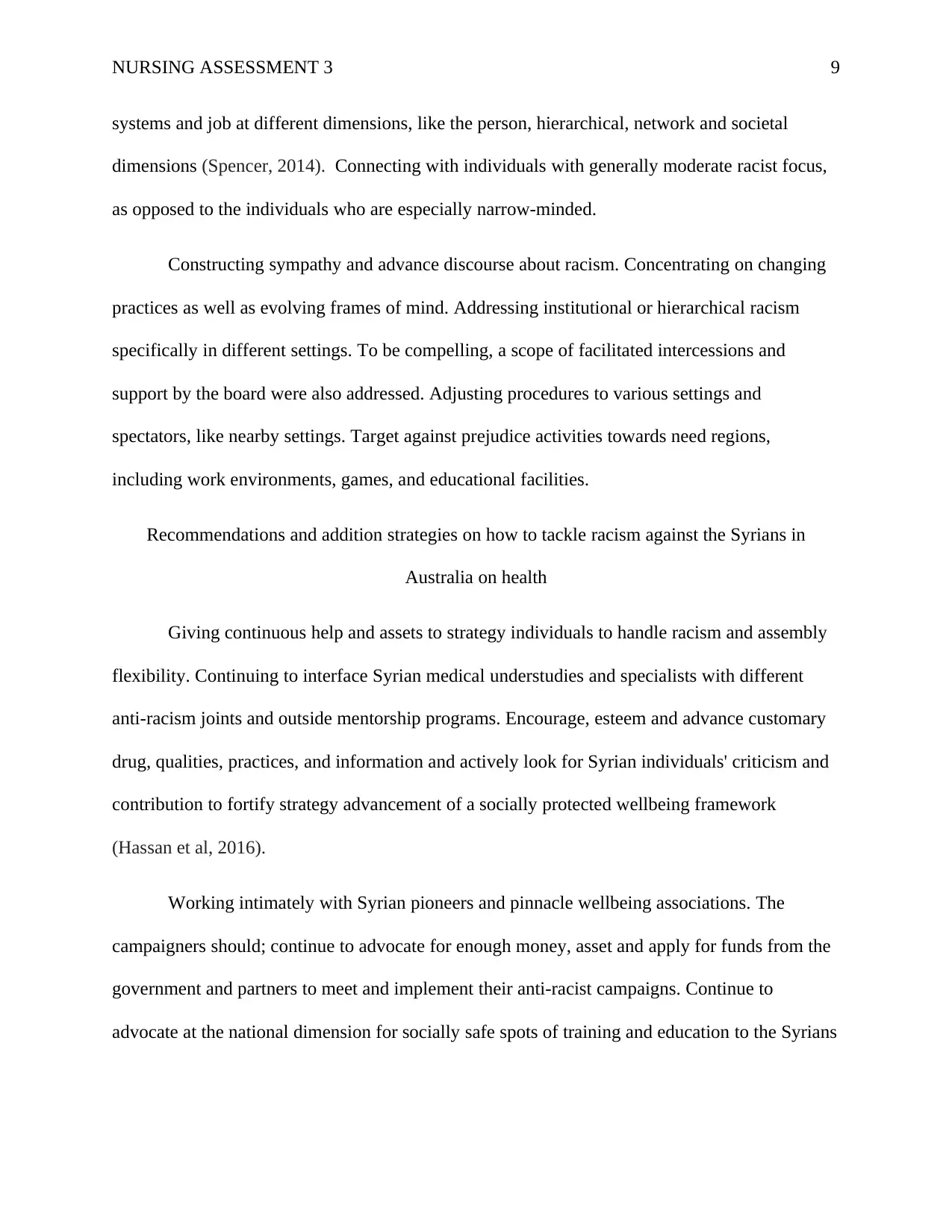
NURSING ASSESSMENT 3 9
systems and job at different dimensions, like the person, hierarchical, network and societal
dimensions (Spencer, 2014). Connecting with individuals with generally moderate racist focus,
as opposed to the individuals who are especially narrow-minded.
Constructing sympathy and advance discourse about racism. Concentrating on changing
practices as well as evolving frames of mind. Addressing institutional or hierarchical racism
specifically in different settings. To be compelling, a scope of facilitated intercessions and
support by the board were also addressed. Adjusting procedures to various settings and
spectators, like nearby settings. Target against prejudice activities towards need regions,
including work environments, games, and educational facilities.
Recommendations and addition strategies on how to tackle racism against the Syrians in
Australia on health
Giving continuous help and assets to strategy individuals to handle racism and assembly
flexibility. Continuing to interface Syrian medical understudies and specialists with different
anti-racism joints and outside mentorship programs. Encourage, esteem and advance customary
drug, qualities, practices, and information and actively look for Syrian individuals' criticism and
contribution to fortify strategy advancement of a socially protected wellbeing framework
(Hassan et al, 2016).
Working intimately with Syrian pioneers and pinnacle wellbeing associations. The
campaigners should; continue to advocate for enough money, asset and apply for funds from the
government and partners to meet and implement their anti-racist campaigns. Continue to
advocate at the national dimension for socially safe spots of training and education to the Syrians
systems and job at different dimensions, like the person, hierarchical, network and societal
dimensions (Spencer, 2014). Connecting with individuals with generally moderate racist focus,
as opposed to the individuals who are especially narrow-minded.
Constructing sympathy and advance discourse about racism. Concentrating on changing
practices as well as evolving frames of mind. Addressing institutional or hierarchical racism
specifically in different settings. To be compelling, a scope of facilitated intercessions and
support by the board were also addressed. Adjusting procedures to various settings and
spectators, like nearby settings. Target against prejudice activities towards need regions,
including work environments, games, and educational facilities.
Recommendations and addition strategies on how to tackle racism against the Syrians in
Australia on health
Giving continuous help and assets to strategy individuals to handle racism and assembly
flexibility. Continuing to interface Syrian medical understudies and specialists with different
anti-racism joints and outside mentorship programs. Encourage, esteem and advance customary
drug, qualities, practices, and information and actively look for Syrian individuals' criticism and
contribution to fortify strategy advancement of a socially protected wellbeing framework
(Hassan et al, 2016).
Working intimately with Syrian pioneers and pinnacle wellbeing associations. The
campaigners should; continue to advocate for enough money, asset and apply for funds from the
government and partners to meet and implement their anti-racist campaigns. Continue to
advocate at the national dimension for socially safe spots of training and education to the Syrians
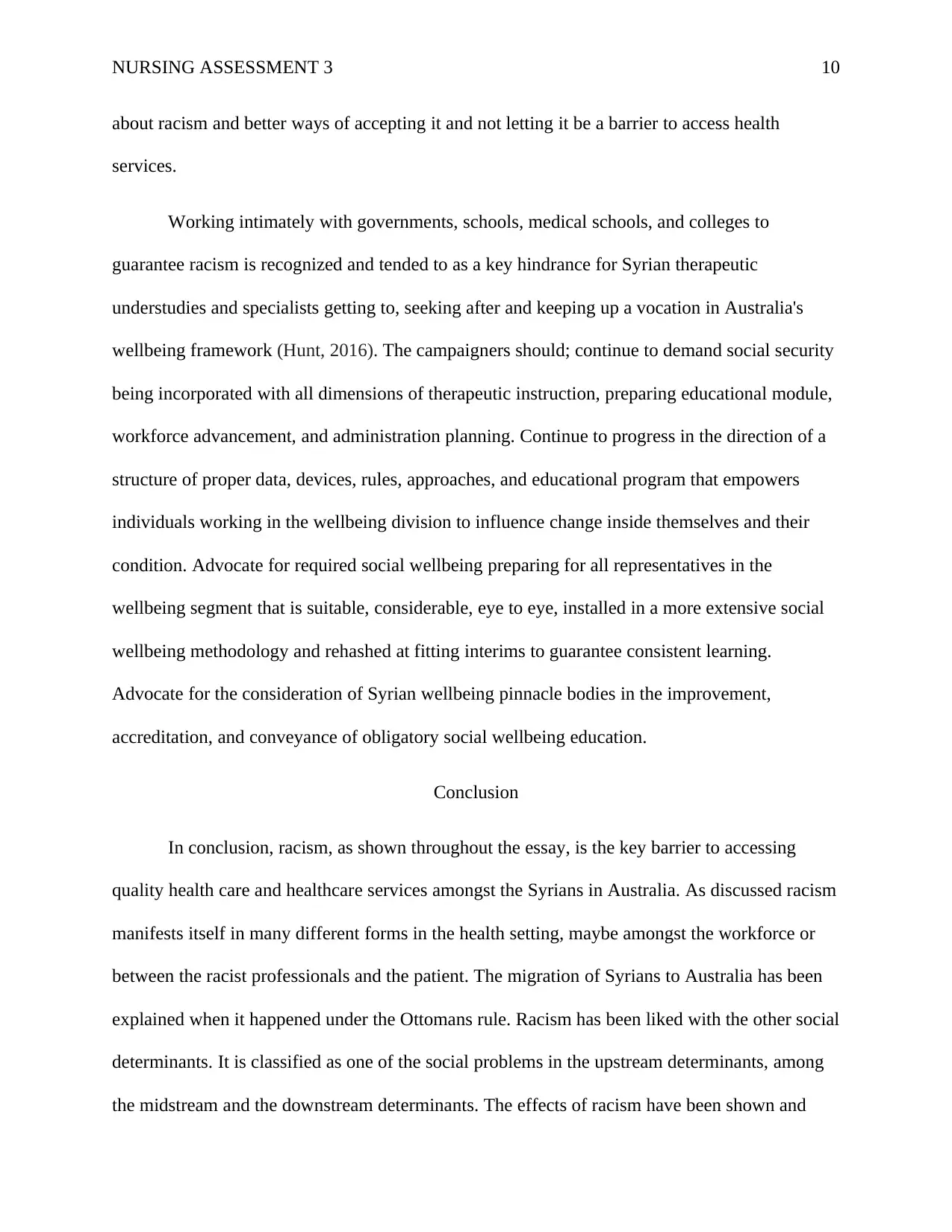
NURSING ASSESSMENT 3 10
about racism and better ways of accepting it and not letting it be a barrier to access health
services.
Working intimately with governments, schools, medical schools, and colleges to
guarantee racism is recognized and tended to as a key hindrance for Syrian therapeutic
understudies and specialists getting to, seeking after and keeping up a vocation in Australia's
wellbeing framework (Hunt, 2016). The campaigners should; continue to demand social security
being incorporated with all dimensions of therapeutic instruction, preparing educational module,
workforce advancement, and administration planning. Continue to progress in the direction of a
structure of proper data, devices, rules, approaches, and educational program that empowers
individuals working in the wellbeing division to influence change inside themselves and their
condition. Advocate for required social wellbeing preparing for all representatives in the
wellbeing segment that is suitable, considerable, eye to eye, installed in a more extensive social
wellbeing methodology and rehashed at fitting interims to guarantee consistent learning.
Advocate for the consideration of Syrian wellbeing pinnacle bodies in the improvement,
accreditation, and conveyance of obligatory social wellbeing education.
Conclusion
In conclusion, racism, as shown throughout the essay, is the key barrier to accessing
quality health care and healthcare services amongst the Syrians in Australia. As discussed racism
manifests itself in many different forms in the health setting, maybe amongst the workforce or
between the racist professionals and the patient. The migration of Syrians to Australia has been
explained when it happened under the Ottomans rule. Racism has been liked with the other social
determinants. It is classified as one of the social problems in the upstream determinants, among
the midstream and the downstream determinants. The effects of racism have been shown and
about racism and better ways of accepting it and not letting it be a barrier to access health
services.
Working intimately with governments, schools, medical schools, and colleges to
guarantee racism is recognized and tended to as a key hindrance for Syrian therapeutic
understudies and specialists getting to, seeking after and keeping up a vocation in Australia's
wellbeing framework (Hunt, 2016). The campaigners should; continue to demand social security
being incorporated with all dimensions of therapeutic instruction, preparing educational module,
workforce advancement, and administration planning. Continue to progress in the direction of a
structure of proper data, devices, rules, approaches, and educational program that empowers
individuals working in the wellbeing division to influence change inside themselves and their
condition. Advocate for required social wellbeing preparing for all representatives in the
wellbeing segment that is suitable, considerable, eye to eye, installed in a more extensive social
wellbeing methodology and rehashed at fitting interims to guarantee consistent learning.
Advocate for the consideration of Syrian wellbeing pinnacle bodies in the improvement,
accreditation, and conveyance of obligatory social wellbeing education.
Conclusion
In conclusion, racism, as shown throughout the essay, is the key barrier to accessing
quality health care and healthcare services amongst the Syrians in Australia. As discussed racism
manifests itself in many different forms in the health setting, maybe amongst the workforce or
between the racist professionals and the patient. The migration of Syrians to Australia has been
explained when it happened under the Ottomans rule. Racism has been liked with the other social
determinants. It is classified as one of the social problems in the upstream determinants, among
the midstream and the downstream determinants. The effects of racism have been shown and
Secure Best Marks with AI Grader
Need help grading? Try our AI Grader for instant feedback on your assignments.
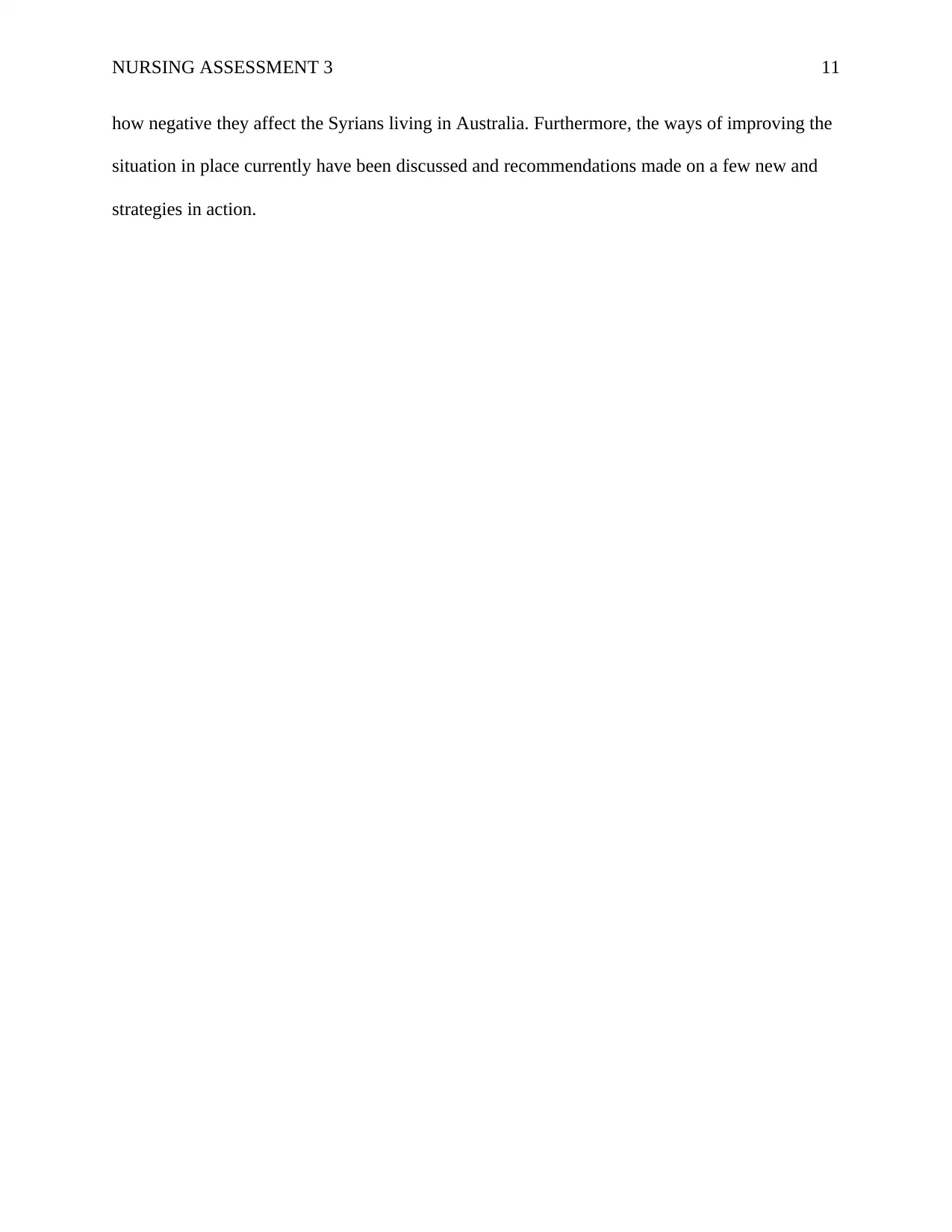
NURSING ASSESSMENT 3 11
how negative they affect the Syrians living in Australia. Furthermore, the ways of improving the
situation in place currently have been discussed and recommendations made on a few new and
strategies in action.
how negative they affect the Syrians living in Australia. Furthermore, the ways of improving the
situation in place currently have been discussed and recommendations made on a few new and
strategies in action.
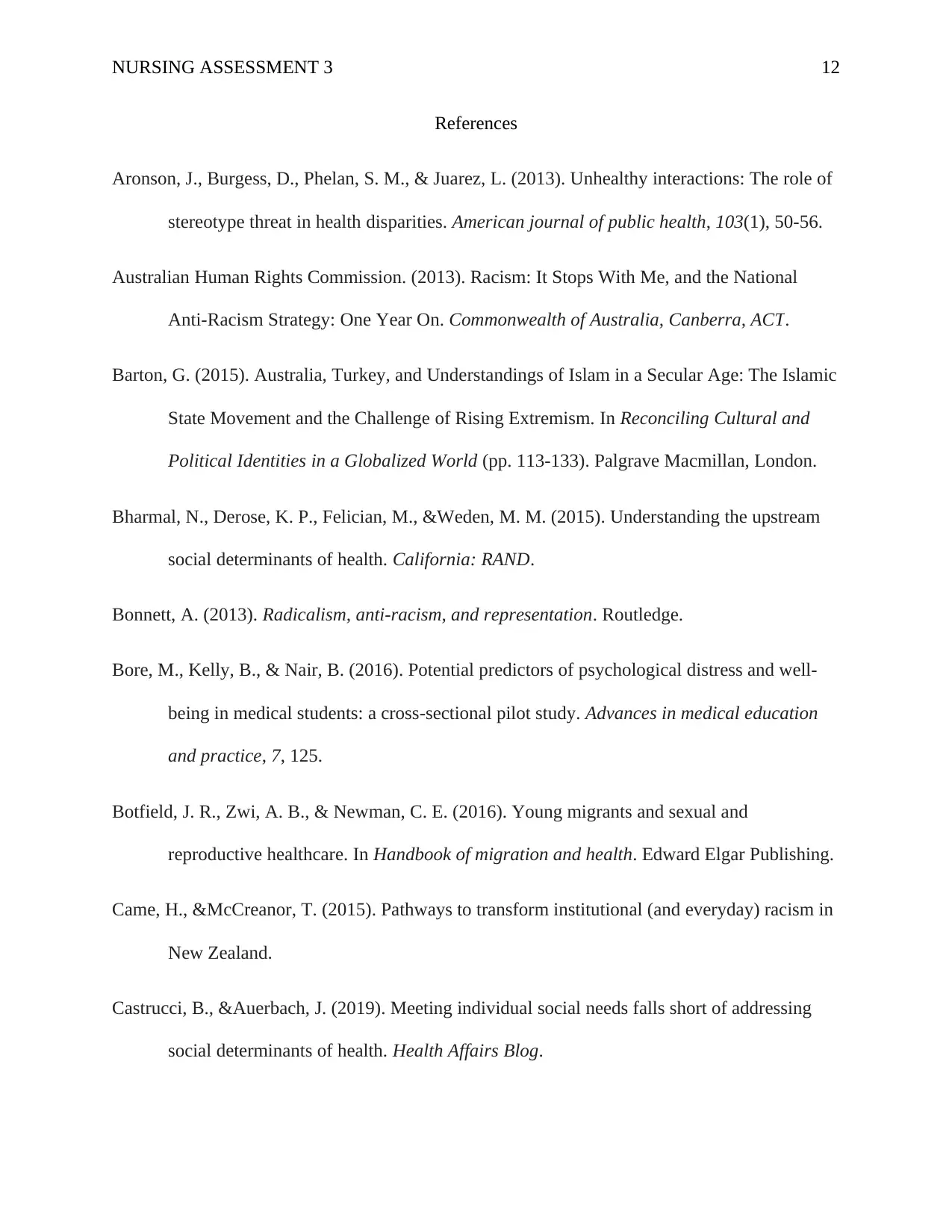
NURSING ASSESSMENT 3 12
References
Aronson, J., Burgess, D., Phelan, S. M., & Juarez, L. (2013). Unhealthy interactions: The role of
stereotype threat in health disparities. American journal of public health, 103(1), 50-56.
Australian Human Rights Commission. (2013). Racism: It Stops With Me, and the National
Anti-Racism Strategy: One Year On. Commonwealth of Australia, Canberra, ACT.
Barton, G. (2015). Australia, Turkey, and Understandings of Islam in a Secular Age: The Islamic
State Movement and the Challenge of Rising Extremism. In Reconciling Cultural and
Political Identities in a Globalized World (pp. 113-133). Palgrave Macmillan, London.
Bharmal, N., Derose, K. P., Felician, M., &Weden, M. M. (2015). Understanding the upstream
social determinants of health. California: RAND.
Bonnett, A. (2013). Radicalism, anti-racism, and representation. Routledge.
Bore, M., Kelly, B., & Nair, B. (2016). Potential predictors of psychological distress and well-
being in medical students: a cross-sectional pilot study. Advances in medical education
and practice, 7, 125.
Botfield, J. R., Zwi, A. B., & Newman, C. E. (2016). Young migrants and sexual and
reproductive healthcare. In Handbook of migration and health. Edward Elgar Publishing.
Came, H., &McCreanor, T. (2015). Pathways to transform institutional (and everyday) racism in
New Zealand.
Castrucci, B., &Auerbach, J. (2019). Meeting individual social needs falls short of addressing
social determinants of health. Health Affairs Blog.
References
Aronson, J., Burgess, D., Phelan, S. M., & Juarez, L. (2013). Unhealthy interactions: The role of
stereotype threat in health disparities. American journal of public health, 103(1), 50-56.
Australian Human Rights Commission. (2013). Racism: It Stops With Me, and the National
Anti-Racism Strategy: One Year On. Commonwealth of Australia, Canberra, ACT.
Barton, G. (2015). Australia, Turkey, and Understandings of Islam in a Secular Age: The Islamic
State Movement and the Challenge of Rising Extremism. In Reconciling Cultural and
Political Identities in a Globalized World (pp. 113-133). Palgrave Macmillan, London.
Bharmal, N., Derose, K. P., Felician, M., &Weden, M. M. (2015). Understanding the upstream
social determinants of health. California: RAND.
Bonnett, A. (2013). Radicalism, anti-racism, and representation. Routledge.
Bore, M., Kelly, B., & Nair, B. (2016). Potential predictors of psychological distress and well-
being in medical students: a cross-sectional pilot study. Advances in medical education
and practice, 7, 125.
Botfield, J. R., Zwi, A. B., & Newman, C. E. (2016). Young migrants and sexual and
reproductive healthcare. In Handbook of migration and health. Edward Elgar Publishing.
Came, H., &McCreanor, T. (2015). Pathways to transform institutional (and everyday) racism in
New Zealand.
Castrucci, B., &Auerbach, J. (2019). Meeting individual social needs falls short of addressing
social determinants of health. Health Affairs Blog.
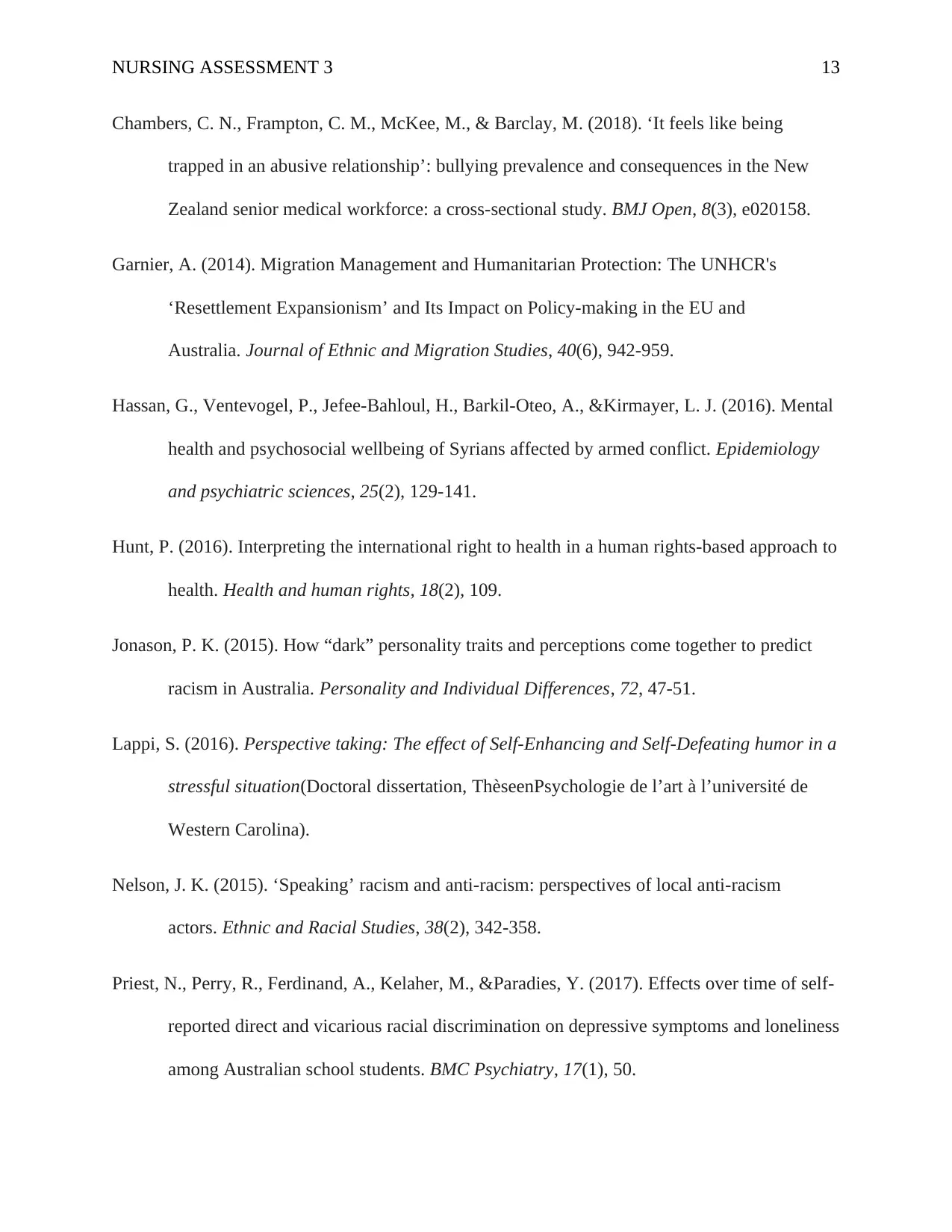
NURSING ASSESSMENT 3 13
Chambers, C. N., Frampton, C. M., McKee, M., & Barclay, M. (2018). ‘It feels like being
trapped in an abusive relationship’: bullying prevalence and consequences in the New
Zealand senior medical workforce: a cross-sectional study. BMJ Open, 8(3), e020158.
Garnier, A. (2014). Migration Management and Humanitarian Protection: The UNHCR's
‘Resettlement Expansionism’ and Its Impact on Policy-making in the EU and
Australia. Journal of Ethnic and Migration Studies, 40(6), 942-959.
Hassan, G., Ventevogel, P., Jefee-Bahloul, H., Barkil-Oteo, A., &Kirmayer, L. J. (2016). Mental
health and psychosocial wellbeing of Syrians affected by armed conflict. Epidemiology
and psychiatric sciences, 25(2), 129-141.
Hunt, P. (2016). Interpreting the international right to health in a human rights-based approach to
health. Health and human rights, 18(2), 109.
Jonason, P. K. (2015). How “dark” personality traits and perceptions come together to predict
racism in Australia. Personality and Individual Differences, 72, 47-51.
Lappi, S. (2016). Perspective taking: The effect of Self-Enhancing and Self-Defeating humor in a
stressful situation(Doctoral dissertation, ThèseenPsychologie de l’art à l’université de
Western Carolina).
Nelson, J. K. (2015). ‘Speaking’ racism and anti-racism: perspectives of local anti-racism
actors. Ethnic and Racial Studies, 38(2), 342-358.
Priest, N., Perry, R., Ferdinand, A., Kelaher, M., &Paradies, Y. (2017). Effects over time of self-
reported direct and vicarious racial discrimination on depressive symptoms and loneliness
among Australian school students. BMC Psychiatry, 17(1), 50.
Chambers, C. N., Frampton, C. M., McKee, M., & Barclay, M. (2018). ‘It feels like being
trapped in an abusive relationship’: bullying prevalence and consequences in the New
Zealand senior medical workforce: a cross-sectional study. BMJ Open, 8(3), e020158.
Garnier, A. (2014). Migration Management and Humanitarian Protection: The UNHCR's
‘Resettlement Expansionism’ and Its Impact on Policy-making in the EU and
Australia. Journal of Ethnic and Migration Studies, 40(6), 942-959.
Hassan, G., Ventevogel, P., Jefee-Bahloul, H., Barkil-Oteo, A., &Kirmayer, L. J. (2016). Mental
health and psychosocial wellbeing of Syrians affected by armed conflict. Epidemiology
and psychiatric sciences, 25(2), 129-141.
Hunt, P. (2016). Interpreting the international right to health in a human rights-based approach to
health. Health and human rights, 18(2), 109.
Jonason, P. K. (2015). How “dark” personality traits and perceptions come together to predict
racism in Australia. Personality and Individual Differences, 72, 47-51.
Lappi, S. (2016). Perspective taking: The effect of Self-Enhancing and Self-Defeating humor in a
stressful situation(Doctoral dissertation, ThèseenPsychologie de l’art à l’université de
Western Carolina).
Nelson, J. K. (2015). ‘Speaking’ racism and anti-racism: perspectives of local anti-racism
actors. Ethnic and Racial Studies, 38(2), 342-358.
Priest, N., Perry, R., Ferdinand, A., Kelaher, M., &Paradies, Y. (2017). Effects over time of self-
reported direct and vicarious racial discrimination on depressive symptoms and loneliness
among Australian school students. BMC Psychiatry, 17(1), 50.
Paraphrase This Document
Need a fresh take? Get an instant paraphrase of this document with our AI Paraphraser
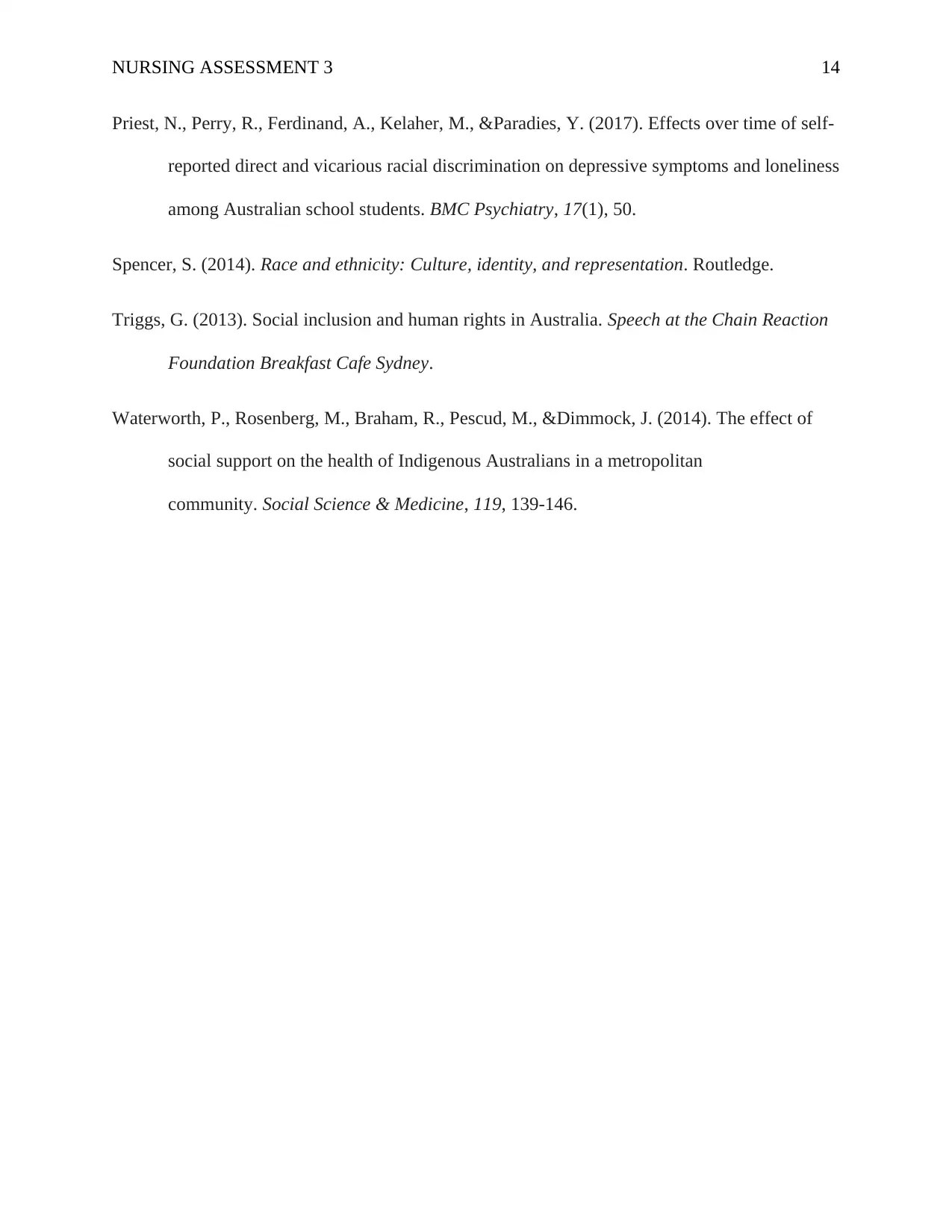
NURSING ASSESSMENT 3 14
Priest, N., Perry, R., Ferdinand, A., Kelaher, M., &Paradies, Y. (2017). Effects over time of self-
reported direct and vicarious racial discrimination on depressive symptoms and loneliness
among Australian school students. BMC Psychiatry, 17(1), 50.
Spencer, S. (2014). Race and ethnicity: Culture, identity, and representation. Routledge.
Triggs, G. (2013). Social inclusion and human rights in Australia. Speech at the Chain Reaction
Foundation Breakfast Cafe Sydney.
Waterworth, P., Rosenberg, M., Braham, R., Pescud, M., &Dimmock, J. (2014). The effect of
social support on the health of Indigenous Australians in a metropolitan
community. Social Science & Medicine, 119, 139-146.
Priest, N., Perry, R., Ferdinand, A., Kelaher, M., &Paradies, Y. (2017). Effects over time of self-
reported direct and vicarious racial discrimination on depressive symptoms and loneliness
among Australian school students. BMC Psychiatry, 17(1), 50.
Spencer, S. (2014). Race and ethnicity: Culture, identity, and representation. Routledge.
Triggs, G. (2013). Social inclusion and human rights in Australia. Speech at the Chain Reaction
Foundation Breakfast Cafe Sydney.
Waterworth, P., Rosenberg, M., Braham, R., Pescud, M., &Dimmock, J. (2014). The effect of
social support on the health of Indigenous Australians in a metropolitan
community. Social Science & Medicine, 119, 139-146.
1 out of 14
Your All-in-One AI-Powered Toolkit for Academic Success.
+13062052269
info@desklib.com
Available 24*7 on WhatsApp / Email
![[object Object]](/_next/static/media/star-bottom.7253800d.svg)
Unlock your academic potential
© 2024 | Zucol Services PVT LTD | All rights reserved.